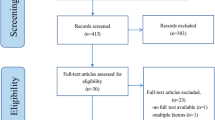Abstract
Nitric oxide (NO) is a controversial molecule. It is either beneficial or deleterious. As with NO donors, one reason for this duality is related to the dose. Small doses are highly beneficial, maintaining blood flow in vessels and blood pressure, and protecting against foreign invaders. In high doses, it results in hypotension, forms peroxynitrite which is cytotoxic, and contributes to heart failure.
Similar content being viewed by others
References
Brunton TL. On the use of nitrate of amyl in angina pectoris. Lancet 1867;2:9–98.
Furchgott RF, Zawadski JV. The obligatory role of endothelial cells in the relaxation of arterial smooth muscle by acetylcholine. Nature 1980;288:37–376.
Palmer RMJ, Ferrige AG, Moncada S. Nitric oxide release accounts for the biological activity of endothelium-derived relaxing factor. Nature 1987;327:52–526.
Ignarro LJ, Lippton H, Edwards JC, et al. Mechanism of vascular smooth muscle relaxation by organic nitrates, nitroprusside and nitric oxide: Evidence for the involvement of S-nitrosothiols as active intermediates. J Pharmacol Exp Ther 1981;218:73–749.
Ignarro LJ. Biosynthesis and metabolism of endotheliumderived nitric oxide. Annu Rev Pharmacol Toxicol 1990;30:53–560.
Moncada S, Palmer RM, Higgs EA. Nitric oxide: Physiology, pathophysiology, and pharmacology. Pharmacol Rev 1991;43:10–142.
Luscher TF. Endogenous and exogenous nitrates and their role in myocardial ischemia. Br J Clin Pharmacol 1992;34(Suppl 1):29S-35S.
Culotta E, Korschland DE Jr. NO news is good news. Science 1992:258:186–1865.
Stamler JS, Singel DJ, Loscalzo J. Biochemistry of nitric oxide and its redox-activated forms. Science 1992;258:189– 1902.
Radomski MW, Palmer RM, Moncada S. The antiaggregating properties of vascular endothelium: Interaction between prostacyclin and nitric oxide. Br J Pharmacol 1987;92:63–646.
Radomski MW, Palmer RM, Moncada S. An l-arginine/ nitric oxide pathway present in human platelets regulates aggregation. Proc Natl Acad Sci USA 1990;87:519–5197.
Vila-Petroff MG, Younes A, Egan J, Lakatta EG, Sollott SJ. Activation of distinct cAMP-dependent and cGMPdependent pathways by nitric oxide in cardiac myocytes. Circ Res 1999;84:102–1031.
Recchia FA, McConnell PI, Bernstein RD, Vgel TR, Xu X, Hintze TH. Reduced nitric oxide production and altered myocardial metabolism during the decompensation of pacing-induced heart failure in the conscious dog. Circ Res 1998;83:96–979.
Murell W. Nitroglycerin as a remedy for angina pectoris. Lancet 1879;1:8–81, 11–115, 11–122, 22–227.
Jugdutt BI. Myocardial salvage by intravenous nitroglycerin in conscious dogs: Loss of beneficial effect with marked nitroglycerin-induced hypotension. Circulation 1983;68:67–684.
Jugdutt BI, Warnica JW. Intravenous nitroglycerin therapy to limit myocardial infarct size, expansion and complications. Effect of timing, dosage and infarct location. Circulation 1988;78:90–919.
Jugdutt BI, Warnica JW. Tolerance with low dose intravenous nitroglycerin therapy in acute myocardial infarction. Am J Cardiol 1989;64:58–587.
Jugdutt BI. Intravenous nitroglycerin unloading in acute myocardial infarction. Am J Cardiol 1991;68:52D-62D.
Stewart DD. Remarkable tolerance to nitroglycerine. Philadelphia Polyclinic 1888;6:43.
Prodger SH, Ayman D. Harmful effects of nitroglycerin: With special reference to coronary thrombosis. Am J Med Sci 1932;184:48–491.
Imhof PR, Ott B, Frankhauser P, Chu LC, Hodler J. Difference in nitroglycerin dose-response in the venous and arterial beds. Eur J Clin Pharmacol 1980;18:45–460.
Jugdutt BI. Nitrates in myocardial infarction. Cardiovasc Drugs Ther 1994;8:63–616.
Fye WB. Nitroglycerin: A homeopathic remedy. Circulation 1986;73:2–29.
Siegfried MR, Erhardt J, Rider T, Ma XL, Lefer AM. Cardioprotection and attenuation of endothelial dysfunction by organic nitric oxide donors in myocardial ischemiareperfusion. J Pharmacol Exp Ther 1992;260:66–675.
Johnson G 3rd, Tsao PS, Lefer AM. Cardioprotective effects of authentic nitric oxide in myocardial ischemia with reperfusion. Crit Care Med 1991;19:24–252.
Keefer LK. Nitric oxide-releasing compounds: From basic research to promising drugs. Mod Drug Discov 1998;1:2–30.
Hare JM, Givertz MM, Creager MA, Colucci WS. Increased sensitivity to nitric oxide synthase inhibition in patients with heart failure. Potentiation of ?-adrenergic inotropic responsiveness. Circulation 1998;97:16–166.
Andrews KL, Triggle CR, Ellis A. NO in the vasculature: Where does it come from and what does it do? Heart Fail Rev 2002;7:42–445.
Paulus WJ, Bronzwaer JGF. Myocardial contractile effects of nitric oxide. Heart Fail Rev 2002;7:37–383.
Wollert K, Drexler H. Regulation of cardiac remodeling by nitric oxide: Focus on cardiac myocyte hypertrophy and apoptosis. Heart Fail Rev 2002;7:31–325.
Oyama J, Frantz S, Blais C, Kelly RA, Bourcier T. Nitric oxide, cell death, and heart failure. Heart Fail Rev 2002;7:32–334.
Mungrue IN, Husain M, Stewart DJ. The role of NOS in heart failure: Lessons from murine genetic models. Heart Fail Rev 2002;7:40–422.
Lalu MM, Wang W, Schultz R. Peroxynitrite in myocardial ischemia-reperfusion injury. Heart Fail Rev 2002;7:35–369.
de Gasparo M. Angiotensin II and nitric oxide interaction. Heart Fail Rev 2002;7:34–358.
Warnholtz A, Tsilimingas N, Wendt M, Munzel T. Mechanisms underlying nitrate-induced endothelial dysfunction: Insight from experimental and clinical studies. Heart Fail Rev 2002;7:33–345.
Jugdutt B. NO and cardioprotection during ischemiareperfusion. Heart Fail Rev 2002;7:39–405.
Rights and permissions
About this article
Cite this article
Jugdutt, B.I. Nitric Oxide in Heart Failure: Friend or Foe. Heart Fail Rev 7, 385–389 (2002). https://doi.org/10.1023/A:1020767731450
Issue Date:
DOI: https://doi.org/10.1023/A:1020767731450




